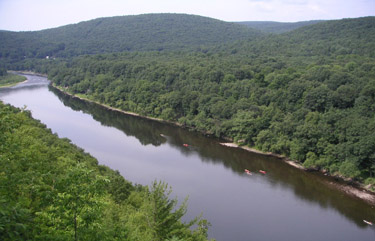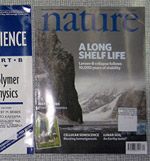Temperatures rising in major U.S. streams and rivers
 Climate,
Climate,  Fish,
Fish,  Freshwater
Freshwater  The water temperature of the Delaware River has been rapidly rising over the last 40 years. Image credit, Seth B. Lyon.Streams and rivers across the United States are becoming noticeably warmer according to a new study published in the journal Frontiers in Ecology and the Environment.
The water temperature of the Delaware River has been rapidly rising over the last 40 years. Image credit, Seth B. Lyon.Streams and rivers across the United States are becoming noticeably warmer according to a new study published in the journal Frontiers in Ecology and the Environment.
A team of researchers led by Sujay Kaushal analyzed historical times series of water records stretching back anywhere from 24 years to almost 100 years for 40 major streams and rivers.
According to the data, 20 of the streams and rivers showed statistically significant long term warming. Another 13 watercourses showed temperature increases that were not statistically significant.
Only 2 streams and rivers showed significant temperature decreases. The study found that the average mean water temperature increased by 0.009–0.077°C per year.
These findings are extremely problematic for fish and other species that inhabit streams and rivers. Many aquatic organisms can only live within narrow temperature ranges.
"Warming of streams and rivers can alter community biodiversity, contribute to local species extinctions, and may facilitate the invasion of alien species," the authors note. For example, macroinvertebrate abundance has been projected to decline 21% for every 1°C increase in stream temperature in parts of the UK.
The study findings provide some evidence that climate change may be at least partly responsible for the temperature increases. "At many sites, long-term increases in water temperatures of streams and rivers typically coincided with historical increases in annual mean air temperatures," the authors write.
However, rising stream temperatures may be due to a number of other factors, as well, including the increase in urbanization and impervious surfaces. The study found that the biggest rates of warming were largely in urbanized areas. However, this was not exclusively the case and some of the urbanized streams saw rising temperatures even after the urban areas had been built out.
Given the projected temperature increases from climate change, the problem is likely to get worse over the coming century. To reduce the warming of streams and rivers, the authors recommend that a number of steps be taken such as the reduction in watershed impervious surfaces and the increased protection and restoration of riparian buffers.
--Reviewed by Rob Goldstein
Kaushal, S., Likens, G., Jaworski, N., Pace, M., Sides, A., Seekell, D., Belt, K., Secor, D., & Wingate, R. (2010). Rising stream and river temperatures in the United States Frontiers in Ecology and the Environment DOI: 10.1890/090037




Reader Comments